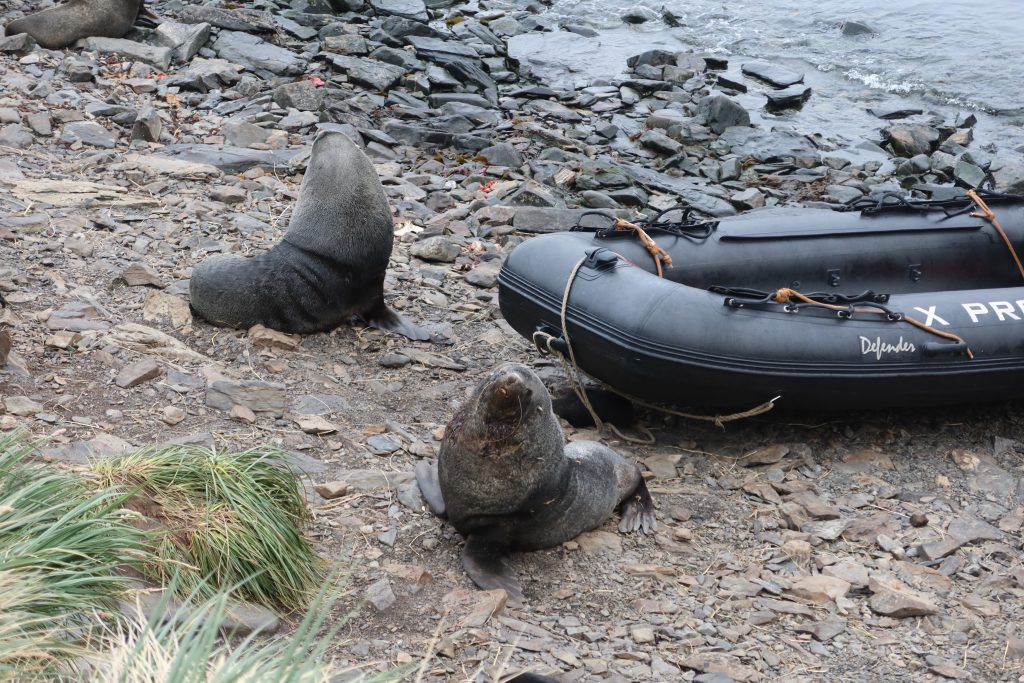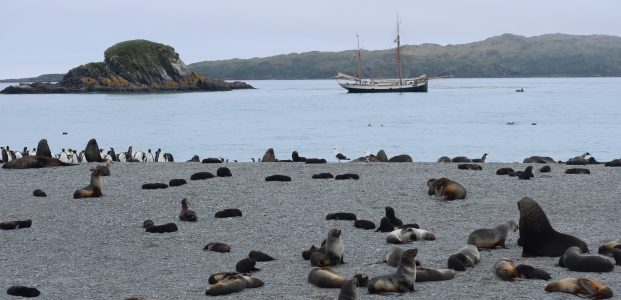Heading up on deck before breakfast, the weather decided to keep me in suspense further as the fog rolled in on the northerly breeze. However, after breakfast it cleared at lower levels and the stunning landscape started to emerge. The beaches were littered with fur seals and elephant seals, from a distance just looking like discarded heaps of stones or rubbish. A closer look through the binoculars though revealed the mass of life all around every accessible area on shore. The noise from them calling just added to the effect.
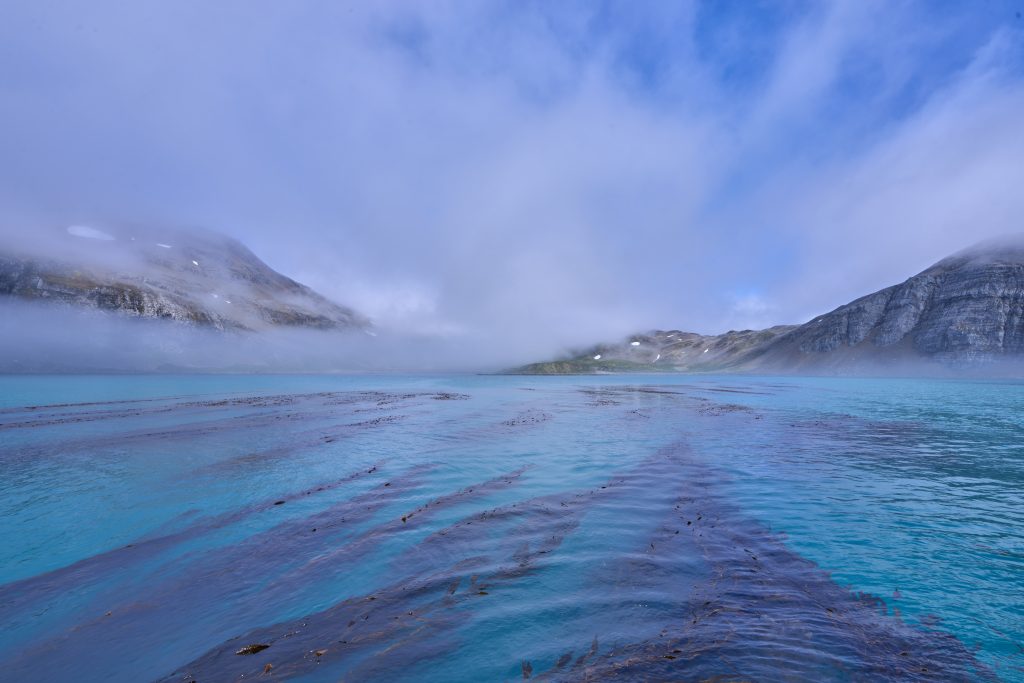
To protect the wildlife when we land, we have been going through extensive bio-security measures. These started with a briefing from Gijs of all the documentation designed to protect and enhance the island’s wildlife. It continued with the more practical elements of the plan. All clothing has to be clean and cleaned. Pockets hoovered out, Velcro undone and cleaned to remove any hairs or other materials, Sellotape used to clear any stray material and soles of boots scrubbed and then dunked in biocide. All bags we are taking (including camera and other bags) have to be cleaned and hoovered. We have also had rat traps on board since the Falklands and these had to be checked when we were 200 miles out and any evidence of rodents reported to the South Georgia government (on the Falklands). The island has undergone extensive work to rid it of reindeer (which were introduced), rats and mice (which devastate the bird populations) and we need to be very careful not to bring anything back which may risk the progress made. The reason for cleaning bags and Velcro and so on is to ensure that we don’t bring any seeds on shore. They have been clearing the island of invasive species and certainly don’t want us adding to that task.
After breakfast we slowly headed off. Slowly mainly because the anchor also brought up massive strands of kelp. Despite being anchored in 16 metres of water we were still in a kelp bed and the anchor tried to bring some of it along with us. To prevent this the dinghy was launched and Gijs gradually cut it away from the anchor with a saw. Anchor free, the kelp, like a marine triffid, decided to have a second go at keeping us in the anchorage by wrapping itself round the prop instead. Some judicious use of the throttle left a kelp soup behind us and ensured we were free to go.
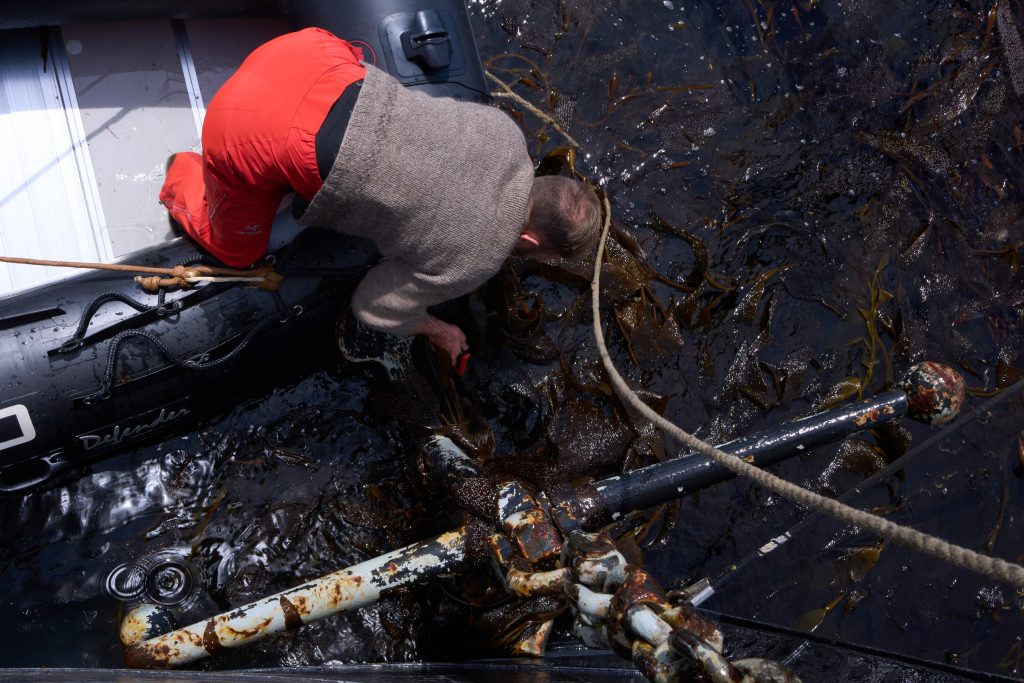
From Rosita Bay we headed round to Salisbury Plain. This is one of the largest flat areas on South Georgia – there was even talk, thankfully gone now, of building an airfield here. As if trying to make a statement that flying from here would be totally inappropriate, it is now the second largest king penguin colony on South Georgia with, it is estimated, 250,000 birds on the beach in the summer when the breeding colonies are active and they are moulting. As well as the king penguins, it is also a home for large numbers of fur seals and some elephant seals. We were very lucky with the weather and with virtually no swell we were able to land off the Zodiac. However, the fur seals treat this very much as their domain and in the breeding season will aggressively protect their harem and pups. So on the first run ashore Tinke and Hidde were left on shore with the paddles from the dinghy to ensure that they were not nibbled by aggressive males. When we arrived we then had to run the gauntlet of seals bellowing and running at us. The key apparently is to avoid eye contact, a difficult thing to do when a large aggressive male fur seal is heading for you teeth bared and roaring. We got through unscathed and onto the larger grass area where the penguins were mainly based. We walked over towards the breeding colony but stayed well clear heading up to the terminal moraine of the glacier. The glacier has retreated some way since, but it still acted as a barrier to the penguins and seals, so we felt a little safer on the higher ground. Returning to the shore we kept close together once again run the gauntlet with a few fairly close shaves and one male being hit on the nose to keep him clear. He retreated at that point to his harem with his pride dented.
It is difficult to do justice adjectivally to Salisbury Plain. The sight of a quarter of a million penguins and chicks, thousands of fur seals and their pups, petrels eating dead carcasses, terns and skuas all together in one place along 2-3 km of beach punctuated at either end by glaciers could be described as jaw-dropping, but even this wouldn’t do it justice. It is nature at its rawest – massive, elemental and sometimes brutal, but nevertheless beautiful and inspiring. At that point, I simply run out of words (but it was awesome!) …..
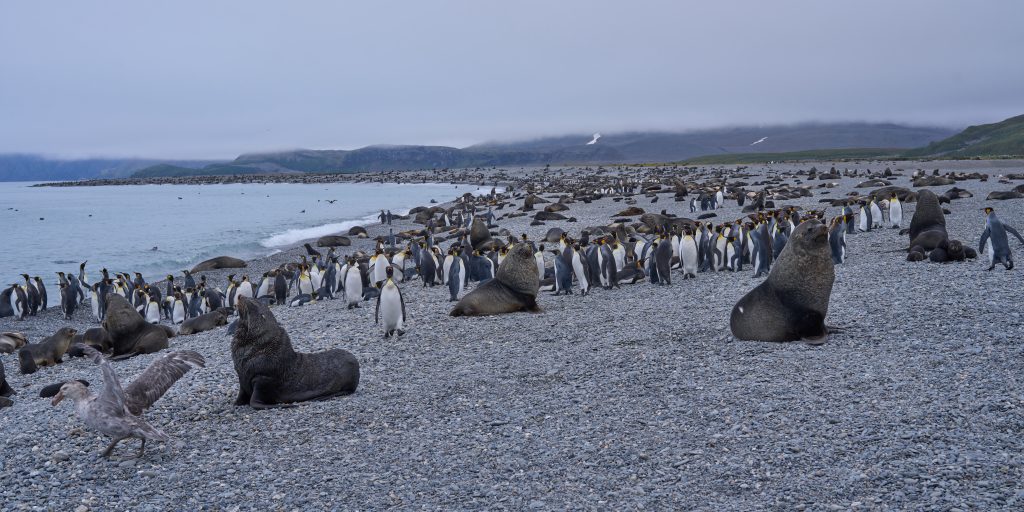
After Salisbury Plain we upped anchor once again and headed round to Prince Olav’s Bay. This is a small sheltered inlet within Cook Bay, so named because it was first explored by Cook. He landed in Possession Bay in January 1775 and of course claimed it for England. Within ten years of this whalers and sealers were ‘harvesting’ the island of seals and penguins. Prince Olav Harbour was a centre for fur sealing operations.
Once anchored next to Brutus Island we headed ashore once again. We first looked at the wreck of the Brutus which gave its name to the nearby island and was gradually being reclaimed by nature. The Brutus was built in Glasgow in 1883 and initially worked in the nitrate trade from Lima. On her ‘retirement’ she was towed into Prince Olav Harbour and used as a coaling hulk to allow ships to refill their stocks. Somehow male fur seals had even clambered on this wreck and a territorial fight between two of them just as we motored past led to one bellyflopping from around 3 metres high in a most inelegant dive. He promptly swam slowly past the bow of the Zodiac preening himself as if to say to us ‘I meant to do that ….’. We then motored past the old whaling station though we were not allowed to get to close – risks from the collapsing structures and asbestos have meant that the old stations are completely off-limits. Even from a distance though, it was nevertheless a spectacular sight and the seals clearly couldn’t read the signs as elephant seals had colonised the buildings while the fur seals had gone for the rest. A few token king penguins looked a little lost in amongst the melee, but they held their ground in the chaos.
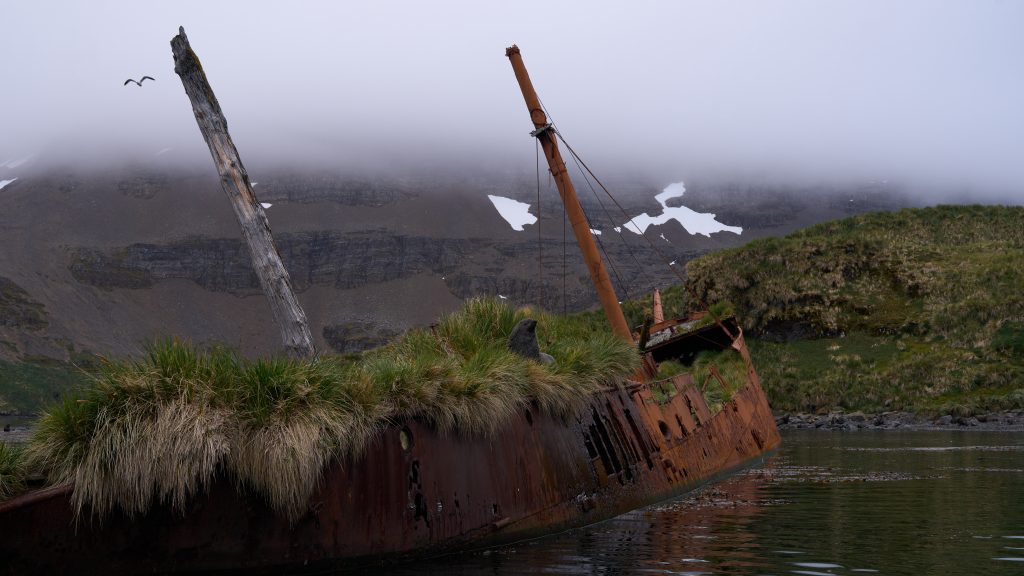
We then ran the seal gauntlet for the third time. This one was a little trickier as there was scarcely a gap on the beach and our landing place had two males already engaged in a territorial dispute. Landing by seals covered in blood doesn’t seem the best start. With some judicious paddle waving we got the boat ashore and headed away from the beach up a small gully. Unfortunately, quite a lot of seals had the same idea, so we were very glad to have the paddles with us to try to keep them at bay. We eventually got to a nice viewpoint over the whaling station and Simon and I sat there while the others headed further up, playing in the snow as they passed it. Heading back down we found two males either side of the Zodiac with a pup asleep under the bow. On the plus side at least they hadn’t got in it! Thanks to the paddles a fourth gauntlet was run without injury and we arrived back on board …..
